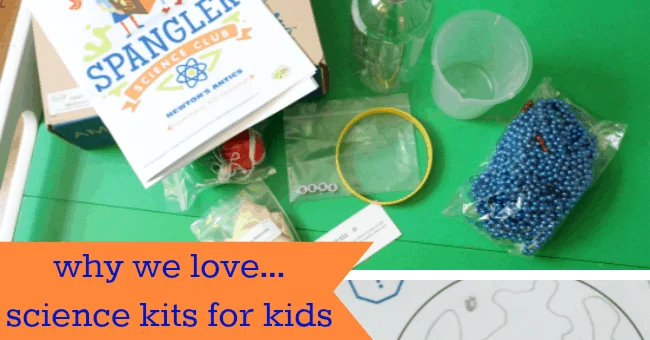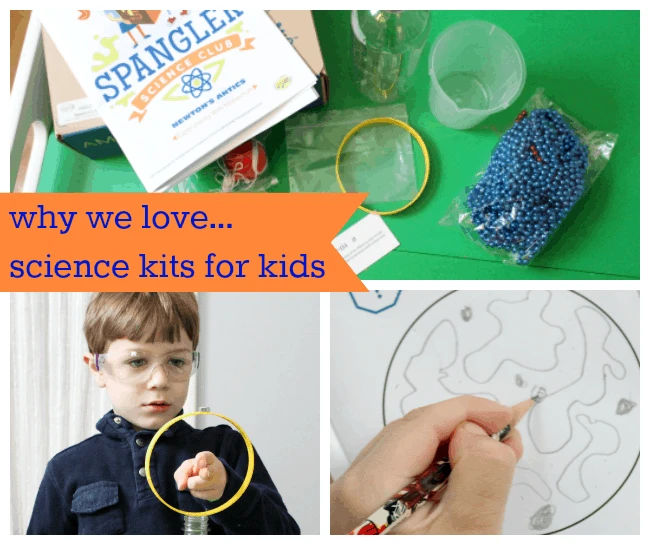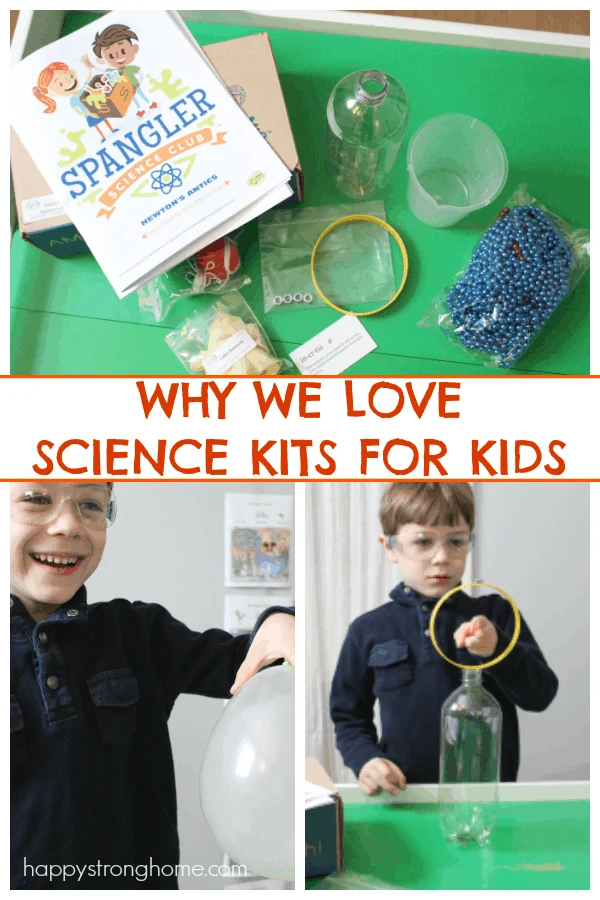I know, I know! My husband is a science teacher. Shouldn’t we be all DIY with the science education? The thing is science experiments are a bit tricky, and the fact is, I am mostly homeschooling on my own during the day, since hubby is ACTUALLY teaching science at a school… so here’s why we love science kits for kids.
Steve Spangler sent us two of their Spangler Science Club boxes to check out recently, and it solidified my love of kits for teaching science. You can view the unboxing videos on Instagram for Invisible Science and Newton’s Antics.

Why we love science kits for kids
There’s burden of proof in law, and then there’s what I call “burden of prep” for the teacher or homeschool parent. Every time you want to teach something, it’s on you to come up with the lesson, materials, and plan. For every subject. Every day. For each student. Wow!
The Spangler Science Club kits are well-developed science kits that take the majority of that burden of prep away, so you can get right into those teachable moments and enjoy the discovery with your child! Each monthly kit is built around a theme: power of air, kitchen chemistry, and so on. Inside the kit are two instruction manuals – one for the student with directions and questions, and one for the parent with tips and background information. All the materials for the experiments are included, with the exception of obvious things like water. We’ve done about eight experiments so far out of the two boxes, and the only thing I added was writing utensils and paper to record / draw data.
Getting your supplies in a kit is both time-saving and economical in the long run. Even if I wanted to buy all the supplies myself (or spend half the day trying to find the right items at home), it’s always so expensive, because you can’t just buy ONE wire thingy, can you? No, and then you end up with all this extra stuff. Although most of the experiments are done with fairly common items, we did have a few specialty products in our boxes like agar petri dishes for growing bacteria, and glowing powder.
Experiments are the WOW factor in your teaching day. Every kid loves to see a fascinating result. The Steve Spangler Science philosophy is all about engaging kids in science exploration by grabbing their attention first. What I love about their science kits is that every experiment has been tried and tested, so you should get true results. Plus, they illustrate step-by-step instructions with clear photos and links to online videos where you can see the same experiment enacted in case you’re having trouble getting it to work. They’ve really covered all the bases.
I appreciate the way the kits help me set up experiments with the right terminology, ask critical thinking questions, and give me ideas for extending the learning beyond the kit. As a home educator, this gives me confidence that I am giving my children a great experience and a great science education based on discovery learning. The Steve Spangler kits follow the scientific method as well, so they are educationally sound, not just a fluffy activity. At the end of each book there’s an extension of the theme into a full-fledged science fair-worthy experiment, using concepts the students have learned along the way with the shorter experiments.
Plus, the experiments are easy to duplicate. The materials are often reusable, so the kids can try the experiment out many times. Or I can revisit the concepts again another day to refresh their memories.
And besides which, what I love most about science kits and experiments is that you can use them with a range of ages, making them perfect for mixed-ages homeschool classrooms!
Experiencing Steve Spangler Science Kits
We explored several experiments from the Newton’s Antics kit first. The boys learned about inertia with the inertia experiment. This was a fairly easy one to grasp and my six year old nailed it after just a few tries. He even presented the experiment to his homeschool group the following week and again nailed it! The balloon experiment was a hit for everyone, and we played with those balloons for several days before they deflated.
What I loved how this kit provided goggles for safety, because it gave me a great opportunity to teach the boys about how we handle ourselves in a “lab” to stay safe and keep those around us safe too.
The Invisible Science Kit gave the boys some real world lessons on how to stay healthy! To learn how invisible bacteria spreads and grows, the boys had fun swabbing doorknobs, light switches, toys, the phone… they were so amazed at how was they couldn’t see quickly grew into gross little dots all over the petri dishes!
The glow powder experiment opened their eyes as well (and was super exciting!). We took the black light into our walk in closet and turned off the lights, then explored how the powder glowed. And how easily it spread from our hands to – well, all over! A great demonstration of invisible bacteria (yeah we still call them germs!) spreading illnesses from person to person.

The lightbulb has definitely gone off about how we can spread illnesses around and they are constantly talking about “seeing the invisible” when I tell them to wash up for dinner!
Get your own science kits or gift them!

The Spangler Science Club starts at $29.99 plus free shipping for a month’s worth of activities (if you explore one concept a week that’s about how long you can stretch each box). Get one box or subscribe for 3- and 12-month options to save a little. A few kits would be a great addition to your homeschooling, be perfect for summer learning projects, or make a fabulous gift for a child.

Thanks to Spangler Science Club for providing kits for our review. All opinions are my own.


Trisha W.
Monday 9th of May 2016
It looks like your young scientists are having so much fun learning and sharing what they learned with others.